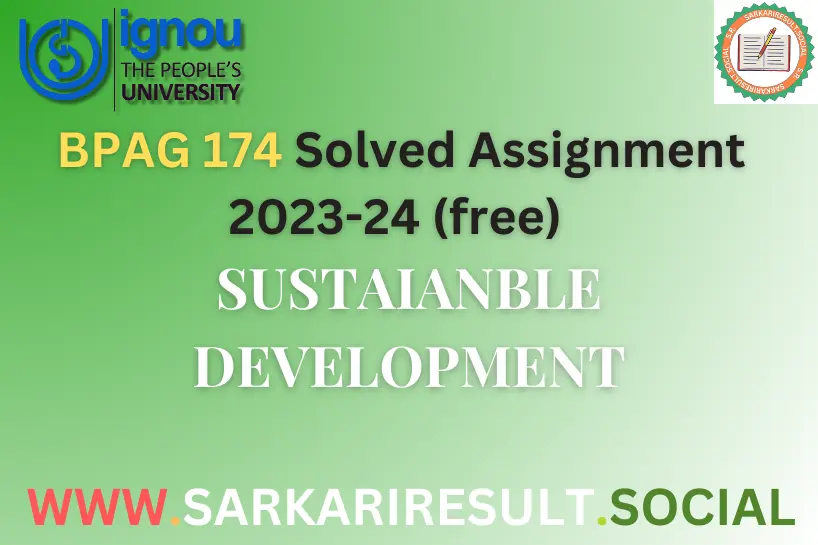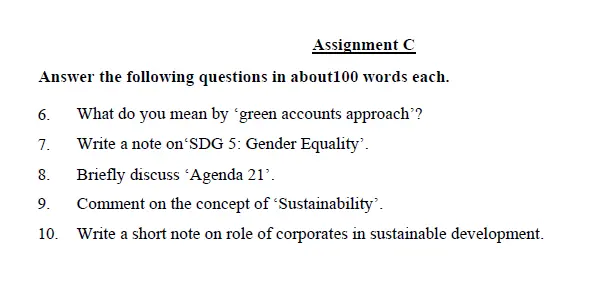Discover BPAG 174 ignou solved Assignment (Free) 2023-24

BPAG 174 ignou solved Assignment (Free) 2023-24
BPAG-174 is an IGNOU course focused on Sustainable Development. This site offers free solved assignments for BPAG-174 IGNOU solved assignment (free) 2023-24, aiding learners in understanding complex concepts and promoting environmental and social responsibility. It supports a brighter, greener future by empowering students with knowledge and skills for sustainable practices. Completing assignments for this course is crucial for academic progress, practical application, and receiving valuable feedback. Submitting assignments contributes to the overall grade and obtaining a certification in Sustainable Development, enhancing career prospects.
Questions and answers (Solved)
Section-A

Q.1 Discuss the meaning and nature of sustainable development.
Ans. Sustainable development refers to the practice of meeting the needs of the present generation without compromising the ability of future generations to meet their own needs. It emerged as a response to the increasing recognition of the negative impacts of unchecked economic growth and environmental degradation.
The concept of sustainable development intertwines social, economic, and environmental aspects, aiming for a balanced and harmonious coexistence between humans and nature.
Meaning of Sustainable Development: At its core, sustainable development seeks to strike a delicate balance between economic growth, social equity, and environmental conservation. It recognizes that economic progress should not come at the cost of environmental degradation and societal injustices. Instead, it advocates for inclusive growth, environmental protection, and social well-being.
Nature of Sustainable Development:
- Interconnectedness: Sustainable development acknowledges the intricate connections between various elements of human life and the environment. Economic decisions can impact the environment, and social policies can influence economic growth. This interdependency necessitates a holistic approach to decision-making.
- Long-term Vision: Sustainable development emphasizes long-term planning and strategies rather than short-term gains. It encourages foresight in policymaking to ensure the preservation of natural resources and the well-being of future generations.
- Inclusivity and Equity: Social justice and equity are fundamental principles of sustainable development. It calls for the inclusion of marginalized and vulnerable populations in development processes, ensuring that the benefits of progress are distributed equitably.
- Environmental Stewardship: Environmental sustainability is a core pillar of sustainable development. It urges responsible management of natural resources, reduction of pollution, and preservation of biodiversity to safeguard the planet’s ecological balance.
- Innovation and Technology: Sustainable development encourages the adoption of innovative technologies and practices that promote resource efficiency, renewable energy, and sustainable consumption patterns.
- Global Cooperation: As environmental issues transcend national boundaries, sustainable development necessitates international cooperation and collaboration to address challenges collectively.
- Resilience and Adaptability: Sustainable development seeks to build resilience in communities and systems to cope with environmental and socio-economic shocks, such as climate change and natural disasters.
Challenges and Opportunities: Despite its noble goals, sustainable development faces challenges in implementation. Balancing economic growth with environmental conservation can be complex, and short-term interests often clash with long-term sustainability objectives. Economic pressures, political barriers, and lack of public awareness can hinder progress.
However, there are also significant opportunities for sustainable development. Innovations in renewable energy, sustainable agriculture, and circular economies present avenues for greener and more inclusive growth. Advancements in education and awareness campaigns can foster a more environmentally conscious and socially responsible citizenry.
Q.2 Describe the relationship between sustainable development and food security.
Ans. Food security is a crucial aspect of sustainable development, as it directly impacts human well-being and social stability. Sustainable development aims to ensure that current and future generations have access to sufficient, nutritious, and safe food while preserving natural resources and promoting responsible agricultural practices. The relationship between sustainable development and food security is symbiotic, as food security is both a critical component of sustainable development and a key factor influencing its success.
The Link between Sustainable Development and Food Security:
- Environmental Sustainability: Sustainable agricultural practices contribute to environmental conservation, which is essential for long-term food security. Practices such as agroecology, organic farming, and conservation agriculture promote soil health, reduce water usage, and protect biodiversity, ensuring the resilience of agricultural systems.
- Social Equity: Sustainable development seeks to address inequalities and promote social inclusion. Ensuring food security for all is a vital aspect of social equity. Sustainable agriculture can create income-generating opportunities for smallholder farmers and reduce food disparities, contributing to poverty reduction and enhanced food access.
- Economic Viability: Sustainable agricultural practices can improve the economic viability of farming communities. By adopting resource-efficient techniques, farmers can increase their productivity, reduce production costs, and access new markets for sustainably produced goods.
- Resilience to Climate Change: Climate change poses a significant threat to food security. Sustainable agricultural practices that enhance ecosystem resilience and adaptability are essential for mitigating the adverse effects of climate change on crop yields and food production.
- Nutrition and Health: Sustainable food systems prioritize the production and consumption of diverse, nutrient-rich foods. Addressing food security from a sustainable development perspective involves ensuring access to healthy diets, thus combating malnutrition and diet-related health issues.
- Reduced Food Waste: Sustainable development emphasizes the reduction of food waste throughout the supply chain. Minimizing food waste not only conserves resources but also increases food availability, contributing to enhanced food security.
- Biodiversity Conservation: Sustainable agriculture fosters biodiversity conservation, which is critical for food security. Diverse ecosystems provide a range of ecosystem services, such as pollination, pest control, and soil fertility, all of which support agricultural productivity.
Challenges and Strategies: Achieving food security within the framework of sustainable development poses several challenges. These include:
- Resource Constraints: Limited availability of arable land, water scarcity, and competition for natural resources can hinder sustainable agricultural practices.
- Policy and Institutional Barriers: Inadequate policies and institutional support can impede the adoption of sustainable agricultural techniques.
- Market Access: Limited access to markets and price volatility can affect the economic viability of sustainable farming.
To overcome these challenges, various strategies are essential:
- Research and Innovation: Continued research and investment in sustainable agricultural technologies and practices can enhance productivity and resource efficiency.
- Capacity Building: Providing training and support to farmers in sustainable agricultural practices can facilitate their adoption.
- Policy Support: Governments need to develop supportive policies that incentivize sustainable farming and promote food security.
- Public Awareness: Raising awareness among consumers about sustainable food choices and reducing food waste can contribute to improved food security.
Section B

Q.3 Examine the environmental components of sustainable development.
Ans. Environmental components are integral to the concept of sustainable development, as they focus on maintaining ecological balance and preserving natural resources for future generations. The environmental components of sustainable development encompass various aspects:
1. Conservation of Biodiversity: Sustainable development emphasizes the protection and conservation of biodiversity.
2. Sustainable Resource Management: Effective management of natural resources, such as water, forests, minerals, and land, is essential for sustainable development.
3. Pollution Prevention and Control: Sustainable development aims to reduce pollution and its adverse impacts on the environment and human health.
4. Climate Change Mitigation and Adaptation: Addressing climate change is a critical environmental component of sustainable development. Mitigation efforts focus on reducing greenhouse gas emissions, while adaptation measures aim to enhance resilience to climate impacts.
5. Renewable Energy Adoption: Transitioning to renewable energy sources, such as solar, wind, and hydropower, is a crucial element of sustainable development. It promotes cleaner energy production and reduces dependence on finite fossil fuels.
6. Sustainable Agriculture: Sustainable agriculture practices emphasize ecological balance, soil health, and reduced chemical use. It aims to ensure food security while minimizing environmental impacts.
7. Water Resource Management: Sustainable development involves responsible management of water resources, including water conservation, wastewater treatment, and equitable access to clean water.
8. Waste Management: Effective waste management, including recycling and proper disposal, is essential for reducing environmental pollution and promoting a circular economy.
9. Ecosystem Restoration: Sustainable development often involves restoring degraded ecosystems to enhance biodiversity and ecosystem services.
10. Environmental Education and Awareness: Creating environmental awareness and promoting education about sustainability are vital to foster a culture of environmental stewardship.
Q.4 Briefly discuss the global governance of climate change.
Ans. The global governance of climate change refers to the collective efforts of nations and international organizations to address the challenges posed by climate change through cooperation, agreements, and policies.
- United Nations Framework Convention on Climate Change (UNFCCC): The UNFCCC, established in 1992, is the central platform for international climate negotiations. It brings together almost all countries to discuss and negotiate actions to combat climate change.
- Kyoto Protocol and Paris Agreement: These landmark agreements were adopted under the UNFCCC. The Kyoto Protocol, in force from 2005 to 2020, set binding emission reduction targets for developed countries. The Paris Agreement, adopted in 2015, aims to limit global warming to well below 2°C above pre-industrial levels, with efforts to limit it to 1.5°C. It includes nationally determined contributions (NDCs) from each country to mitigate greenhouse gas emissions.
- Conference of the Parties (COP): COP is the highest decision-making body of the UNFCCC. It meets annually to assess progress, negotiate new commitments, and discuss climate-related issues.
- Intergovernmental Panel on Climate Change (IPCC): The IPCC is a scientific body that provides policymakers with objective, scientific information on climate change, its impacts, and potential adaptation and mitigation strategies.
- Green Climate Fund (GCF): The GCF is a financial mechanism under the UNFCCC, established to support climate action in developing countries. It provides funding for climate projects and initiatives to promote sustainable development.
- Climate Technology Centre and Network (CTCN): The CTCN supports developing countries in accessing environmentally sound technologies and building technological capacity to address climate change challenges.
Q.5 Explain the characteristics of Green Technologies.
Ans. Green technologies, also known as sustainable or clean technologies, refer to innovative practices, processes, and products designed to promote environmental sustainability and reduce negative impacts on the planet. The characteristics of green technologies include:
- Environmentally Friendly: Green technologies are developed with a primary focus on minimizing harm to the environment. They aim to reduce greenhouse gas emissions, pollution, and resource depletion.
- Energy Efficiency: Many green technologies prioritize energy efficiency, striving to achieve the same level of performance while consuming fewer resources. This includes energy-efficient appliances, lighting, and building designs.
- Renewable Energy Sources: Green technologies often harness renewable energy sources such as solar, wind, hydro, geothermal, and biomass to generate power. These sources are abundant, sustainable, and produce little or no greenhouse gas emissions.
- Waste Reduction and Recycling: Green technologies emphasize waste reduction and recycling to minimize the burden on landfills and conserve natural resources. They promote the concept of a circular economy, where materials are reused, repurposed, or recycled.
- Sustainable Agriculture: Agricultural green technologies prioritize eco-friendly practices like organic farming, crop rotation, and integrated pest management. They promote soil health, conserve water, and reduce the use of chemical inputs.
- Water Conservation: Technologies that promote water conservation, such as low-flow fixtures, rainwater harvesting systems, and efficient irrigation methods, are considered green due to their positive impact on water resources.
- Environmental Monitoring and Data Analysis: Green technologies often utilize advanced sensors, data analytics, and artificial intelligence to monitor environmental conditions and optimize resource usage.
Section-C

Q.6 What do you mean by ‘green accounts approach’?
Ans. The ‘green accounts approach’ refers to a method of accounting that incorporates environmental factors and natural resources into economic decision-making. It involves calculating and analyzing the environmental costs and benefits of economic activities alongside financial data. This approach helps in understanding the true impact of economic development on the environment and assists policymakers and businesses in making more sustainable and informed decisions.
Q.7 Write a note on ‘SDG 5: Gender Equality’.
Ans. Sustainable Development Goal 5 (SDG 5) focuses on achieving gender equality and empowering all women and girls. It aims to eliminate discrimination, violence, and harmful practices against women, ensuring equal opportunities in education, employment, and leadership roles. SDG 5 seeks to address gender disparities, promote women’s rights, and create an inclusive society where women can participate and contribute to social, economic, and political development on an equal footing with men.
Q.8 Briefly discuss ‘Agenda 21’.
Ans. Agenda 21 is a comprehensive action plan adopted during the United Nations Conference on Environment and Development (UNCED) held in Rio de Janeiro in 1992. It is a blueprint for sustainable development that outlines strategies for addressing environmental, social, and economic challenges. Agenda 21 emphasizes the importance of global cooperation to achieve sustainable development goals and sets forth principles and action plans for sustainable development at the local, national, and international levels.
Q.9 Comment on the concept of ‘Sustainability’.
Ans. Sustainability refers to the ability to meet the needs of the present generation without compromising the ability of future generations to meet their own needs. It involves a balance between economic, social, and environmental dimensions to ensure long-term well-being and prosperity. Sustainability requires responsible resource management, environmental protection, social equity, and the adoption of practices that do not deplete or degrade natural resources. It aims to create a harmonious relationship between humans and the environment, promoting a resilient and equitable future.
Q.10 Write a short note on role of corporates in sustainable development.
Ans. Corporates play a vital role in sustainable development through their business practices, policies, and social initiatives. By adopting sustainable practices, corporates can reduce their environmental impact, conserve resources, and mitigate climate change. They can promote social responsibility by supporting community development, education, and healthcare initiatives. Additionally, corporates can influence supply chains to adopt sustainable practices and encourage innovation in green technologies. Embracing sustainability not only enhances a company’s reputation and competitiveness but also contributes to the achievement of broader sustainable development goals at a global level.
Disclaimer
The following questions and answers BPAG 174 Ignou Solved Assignment (FREE) 2023-24 have been provided for informational purposes only. While efforts have been made to provide accurate and up-to-date information, the content should not be considered as professional advice. Users are encouraged to verify any information independently. The website and its operators do not assume any liability for the use or interpretation of the content provided. Visitors are advised to consult relevant experts or professionals for specific guidance and assistance. By using this website, you agree that the website and its operators are not responsible for any consequences arising from the use of the information provided. Thank you !!!







